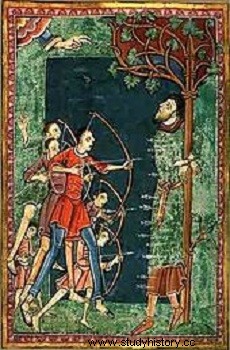
Edmund the Martyr (died November 20, 869) was the last king of East Anglia before the conquest of this kingdom by the Vikings. Considered a saint after his death, his feast day is November 20.
Due to a lack of written records, the late history of the kingdom of East Anglia is poorly understood, and Edmund's reign is no exception. The Anglo-Saxon Chronicle, compiled at the end of the 9th century in Wessex, says little about the events in East Anglia, and is content to report his death in battle against the Danes of the Great Army in 870 at Thetford. Later texts date his accession to 855.
His coins suggest that he succeeded the (equally poorly known) kings Æthelstan and Æthelweard. They can be classified into two periods:the oldest are generally marked + eadmvnd rex an, while the later ones are simply + eadmvnd rex.
Cult
The martyrdom of Edmond.
After his death, Edmund was the object of a particularly strong cult among the Danes of East Anglia. This cult has its nucleus at Beodricsworth Abbey, where its relics are transported around 900-920. The abbey and town subsequently took the name of Bury St Edmunds in his honour. The same period saw the minting of commemorative coins bearing the mention sce eadmvnd rex “O Saint Edmund the King! ". These coins circulate abundantly in the Danelaw, and have been found in many buried treasures.
Edmond's life became the subject of legends, and the monk Abbo de Fleury relied on these popular and monastic traditions to write a hagiography of the king during his stay at Ramsey Abbey between 985 and 987. He claims to hold his story from Archbishop Dunstan of Canterbury, who himself had it from the King of Edmund's Armor Bearer. In this Passio S. Eadmundi, Edmond appears as an “ideal Christian sovereign”:he refuses to go into battle against the Vikings, who subject him to martyrdom. The king is molested, tied to a tree and riddled with arrows; still refusing to deny his faith, he is eventually beheaded. Abbo names his assassin Hinguar, probably a distortion of the name Ivar the Boneless. His account is taken up by Ælfric the Grammarian in his Lives of Saints written in Old English.
Edmond is considered the patron saint of the Kingdom of England before being supplanted by Edward the Confessor in the 11th century, then by Saint George from the 14th century. His shrine in Bury St Edmunds was destroyed during the Dissolution of the Monasteries in the 16th century.
Edmond is still celebrated on November 20 by the Catholic Church. He is commonly depicted with an arrow in his hand (for example on Wilton's diptych), or appears tied to a tree, riddled with arrows. It is distinguished from the representation of Saint Sebastian by the wearing of a royal crown and the presence of a wolf. He is the patron saint of Douai Abbey, the Catholic Diocese of East Anglia and the county of Suffolk. Several churches are dedicated to him, including St Edmund, King and Martyr in London.
